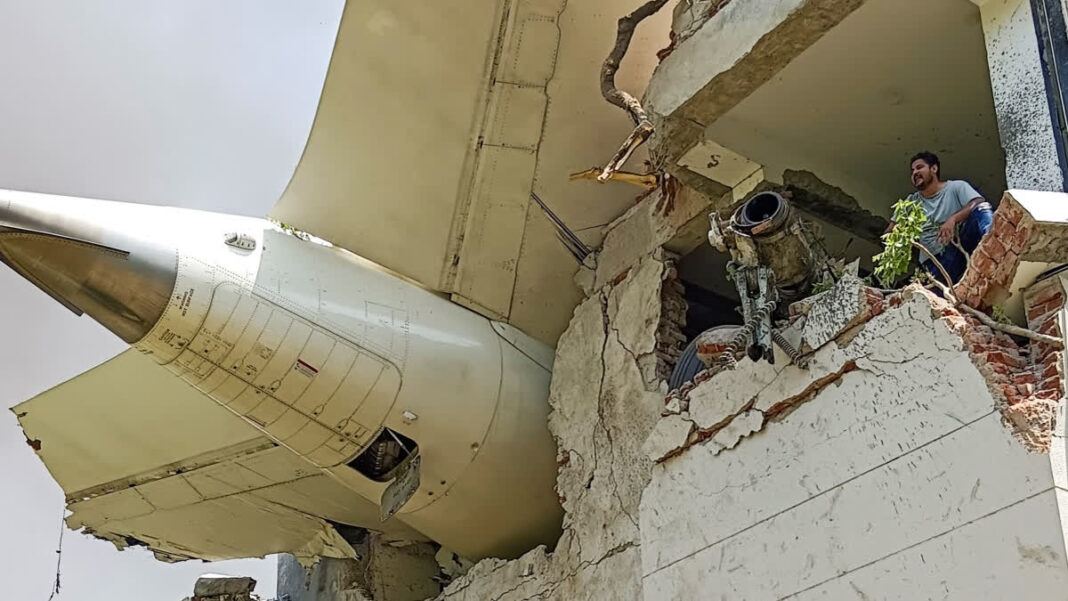Less than a minute after lifting off from the runway, Air India Flight AI-171 disappeared from radar and slammed into a student hostel near B.J. Medical College.
The Boeing 787 Dreamliner was carrying 242 people on board. Only one of them survived.
Vishwashkumar Ramesh, seated in 11A, climbed from the wreckage in a daze. “Everything happened in front of my eyes,” he told The Hindu. “I thought I would die.” His voice, still trembling, echoed the horror of one of India’s worst aviation disasters in decades.
As investigators comb through the charred debris, a global community of aviation experts is working to understand how a modern jetliner — considered among the safest — could fall from the sky less than 40 seconds after takeoff.
Early Theories: Engines, Flaps, and Drag
In interviews across multiple outlets, experts say the crash may have stemmed from a sudden loss of lift — possibly triggered by a combination of mechanical missteps and human error.
“It looks like the aircraft struggled to gain altitude almost immediately,” said Dr. Sonya Brown, an aerospace engineering professor at the University of New South Wales, speaking to the BBC. “That can point to thrust problems, or issues with the flaps not being properly configured.”
A widely circulated video appears to show the Dreamliner climbing unusually slowly before banking and crashing nose-first.
Aviation safety consultant John M. Cox noted in a Sky News interview that “the flaps do not appear to be in a takeoff position.”
Without proper flap deployment, an aircraft cannot generate the necessary lift at low speeds.
Capt. Amit Singh, a former Air India pilot and current aviation analyst, observed that the landing gear was still down during the short flight.
“Normally, gear retraction begins within seconds after takeoff,” he told The Indian Express. “Leaving it down creates drag — it’s like trying to run with parachutes on your legs.”
Boeing, GE Join International Probe
The U.S. National Transportation Safety Board (NTSB) and Boeing have sent teams to India to assist the Aircraft Accident Investigation Bureau (AAIB), which is leading the inquiry.
British regulators and engine manufacturer GE Aerospace are also participating.
The aircraft’s flight data recorder has been recovered, but officials have not yet confirmed whether the cockpit voice recorder — critical for understanding pilot decisions in the final moments — has been located.
Investigators are focusing on several possibilities: a dual-engine failure, a misconfigured flap setting, or a scenario in which the gear and flaps remained extended, creating too much drag for the aircraft to climb. A bird strike is no longer being considered a primary cause.
“There are no visible birds in the CCTV footage,” said Capt. Manoj Hathi, a retired Air India safety official, speaking to NDTV. “The crash signature suggests a stall — but we need the data to confirm.”
Temperatures and Timing
The crash occurred during peak afternoon heat, with temperatures topping 40°C (104°F). Hotter air is thinner, which can impact lift, particularly if other systems are already under strain.
“That kind of heat doesn’t crash planes on its own,” said Alastair Rosenschein, a former British Airways pilot, in an interview with Sky News. “But it makes any mistake — mechanical or human — that much less forgiving.”
Some experts have suggested a fuel contamination scenario, or a possible miscommunication between pilots during a high-stress takeoff procedure. “A wrong lever pulled, a misread gauge — it’s happened before,” Rosenschein added.
A Plane Meant to Be Safe
The Boeing 787 Dreamliner, first delivered in 2011, has maintained an excellent safety record. Until this crash, there had been no fatal accidents involving the model.
That record is cold comfort to the families of those who died — many of them students, families, and medical professionals heading abroad. Authorities are conducting DNA identification, and Air India has pledged compensation of ₹1 crore ($120,000) to each victim’s family.
Meanwhile, India’s Directorate General of Civil Aviation has ordered immediate inspections of all Dreamliners operated by Indian carriers.
The Human Cost
In Ahmedabad, anger and grief are mounting. The hostel that bore the brunt of the impact housed medical interns — at least 28 people on the ground also lost their lives.
“I saw fire falling from the sky,” said Ramesh Patel, a local resident, whose son narrowly escaped the hostel before it caught fire. “It was like a war zone.”
For Vishwash Ramesh, the lone survivor, survival is a haunting mystery. “I still can’t believe I’m here,” he said in a brief hospital statement. “Everyone else… they were gone in seconds.”
As investigators work to reconstruct the final 33 seconds of AI-171’s flight, families wait for answers, and the world watches closely.
A full report could take months — but even now, the evidence is building a tragic, avoidable picture of confusion, mechanical failure, and missed moments that cost 260 lives.
Also Read
Silver Airways Ceases All Operations, Cancels All Flights Amid Bankruptcy Sale
Goodbye America? Inside the Report Revealing Where 116,000 Americans Plan to Move

